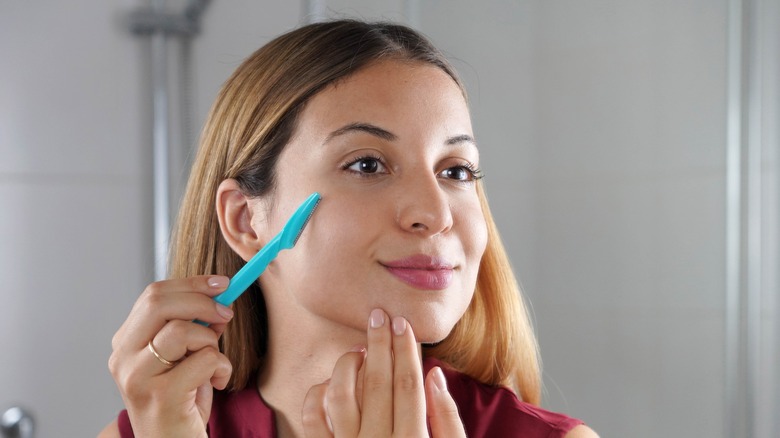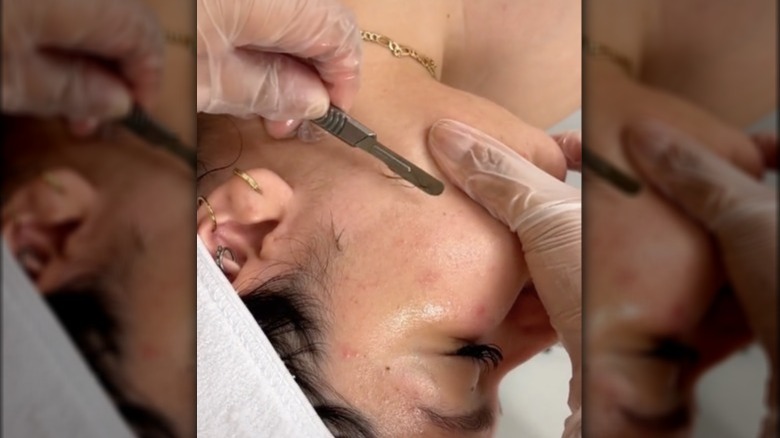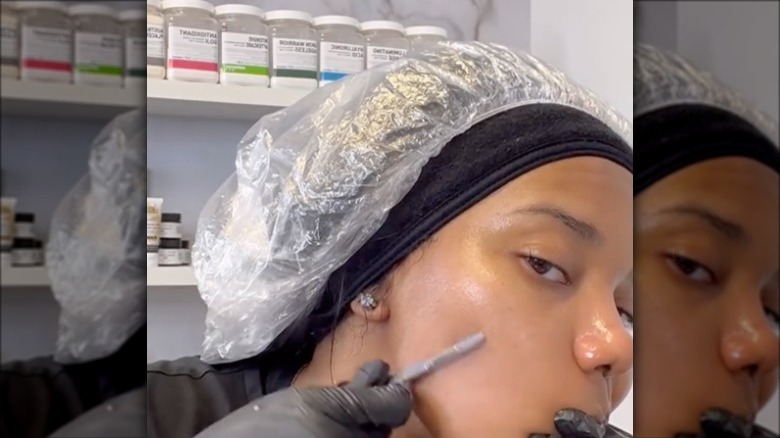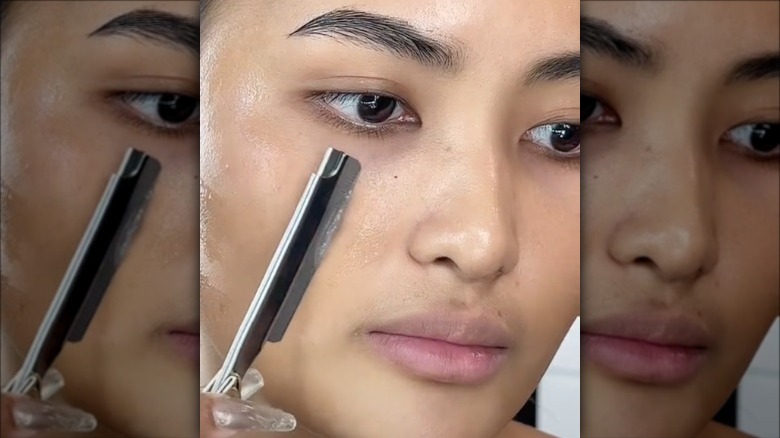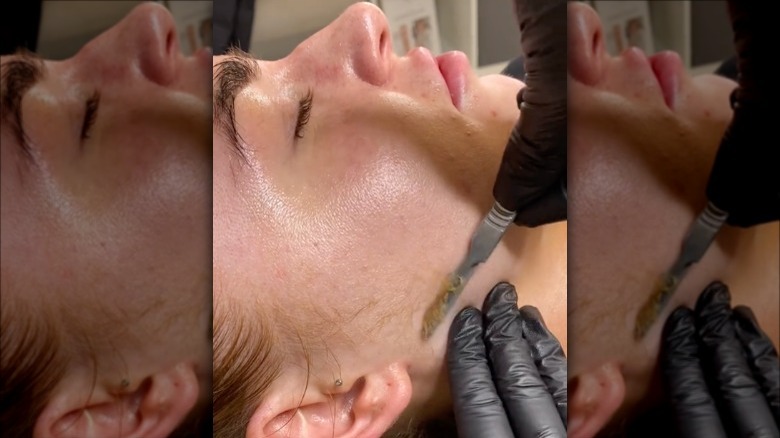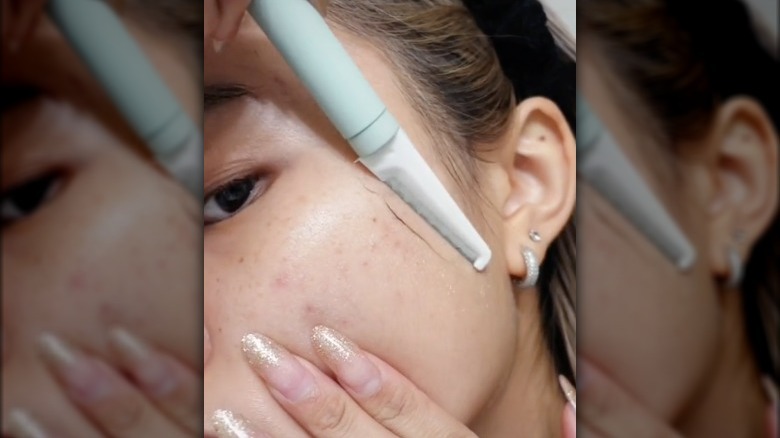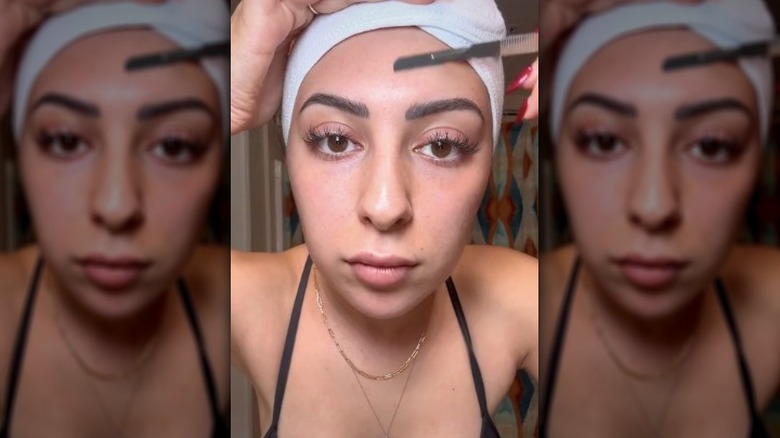Dermaplaning Vs. Oilplaning: The Real Differences Between The Shaving Methods
Skincare is an essential piece of many beauty routines, causing new trends and products to be the "it" item of the moment. In the quest to achieve healthy, smooth, radiant skin, many people have replaced a quick rinse and a little moisturizer with multi-step routines and techniques taken from the dermatologist's office.
One of those being dermaplaning, a technique that involves gently shaving the face to remove peach fuzz, as well as oil, dirt, and dead skin cells. When done at a dermatologist's office, a sterilized surgical scalpel is used to scrape the skin. However, at home, there are scalpel-shaped razors that can be used to remove the fine hair on the face.
An alternative to dermplaning, oilplaning is another popular exfoliation technique. Where dermaplaning is performed on dry skin, oilplaning uses a facial oil. This is just one of the differences between the two shaving methods.
Dermaplaning goes beyond your average shave
For dermatologists, dermaplaning is a simple procedure that uses a surgical blade to remove fine facial hairs and the top layer of skin. The procedure isn't painful and can be a relatively quick method of resurfacing, only requiring about 20 to 30 minutes to finish. While it is like shaving, dermaplaning tools only have one blade, where a standard razor could have between three to five. Shaving also only removes the hair while dermaplaning also removes the top layer of the epidermis, making it more of an exfoliating treatment than a method of hair removal.
When done correctly by a professional, dermaplaning can actually be a better option than shaving. The method not only removes hair, but can also be effective for making skin smoother and softer because it can take off the rough top layers. Dermaplaning is effective for treating hyperpigmentation that's on the surface of the skin as well as some minor scars, leading to a brighter and more even skin tone. With continued use, it can also be great for anti-aging, wrinkles, and fine lines. Be cautious about dermaplaning treatments if you have inflamed acne or raised lesions, warns McLean & Potomac Dermatology. If you have an allergy to nickel, you may find yourself allergic to the dermaplaning scalpel.
Oilplaning is better for sensitive skin
In terms of procedure, there is only one major difference between dermaplaning and oilplaning. And as the name suggests, it's oil. Oilplaning utilizes facial oils, which help create a barrier and allow the blade to glide smoother against the skin. This protects against irritation and is the better option for those who have sensitive or dry skin or skin that easily reacts or gets irritated, as well as more mature skin, dermatologist Dr. Alexis Stephens says in a YouTube video.
Dr. Stephens recommends oils that have vitamin F because it promotes a healthy skin barrier while also improving hyperpigmentation and acne. It's light and doesn't clog pores, so it can also be a great choice for oily skin. She recommends rose hip seed, squalane, hemp seed, and sunflower seed oil for oilplaning. Argan oil can also be a good option because it has moisturizing properties through vitamin E and omega fatty acids. It also has some benefits of controlling sebum production, which can prevent breakouts for those who may have oily skin.
Dermaplaning and oilplaning at home
Because of the many benefits, skincare fanatics are looking to incorporate this procedure into their regular routines. But can you do dermaplaning and oilplaning at home? There are mixed opinions from professionals on whether this is something the average person should try on their own. While many experts say yes as long as you proceed with caution, others are completely against it.
Because dermaplaning uses a surgical instrument, it's best to be trained on how to use it before putting it against your skin. Dr. Maja Swierczynska, London's STORY clinic's lead aesthetic practitioner, tells Healthline, "Without knowing the correct technique, such as the right angle and how you should hold the blade, you can easily cut the skin and this can lead to infection." Beyond the risks of injury, the results may not be as noticeable when done at home.
The experts that say you can dermaplane or oilplane at home note that it's all about choosing the right tools. It's not wise for the average person to use a surgical scalpel to scrape away hair and dead skin. Instead, opt for a single-edge blade made from stainless steel. You'll want to do this, at most, once a week or every two or three weeks if you have sensitive skin. And wait at least 24 hours before doing another form of exfoliation.
Side effects of dermaplaning and oilplaning
Compared to other exfoliating procedures, the side effects of dermaplaning and oilplaning are minimal. Some redness is one of the most common side effects of dermaplaning (and of many exfoliants, for that matter). The redness and inflammation can lead to whiteheads. Patchy skin can also be a side effect, but this can disappear with time. On the more serious side, dermaplaning can lead to infection and scarring, though these are quite rare. These will typically come from improper technique.
With oilplaning, adequate preparation is even more important when it comes to avoiding side effects. "If the face isn't properly cleansed and there is dirt, oil, or makeup on the skin, it can cause the dermaplaning blade to slip and nick the skin, spreading debris and bacteria," board-certified dermatologist Aanand Geria, MD explains to Byrdie. The oil can also seep into and clog pores, which sets the stage for breakouts. And finally, if you aren't careful with the blade, it could slip and cut the skin.
Tools and technique make a difference
What sets dermaplaning and oilplaning apart from shaving is the kind of blade you use. The single sharp edge cuts cleaner than your typical shaving razor, reducing the risk of ingrown hairs and irritation. When done in the salon, dermaplaning and oilplaning involves a surgical scalpel. But as PMUHub notes, you shouldn't use this tool at home because the lack of training could lead to injury or scars.
Of course, the major difference between dermaplaning and oilplaning is the addition of face oil. You want an oil that has emollients, or moisturizing effects, to help protect and restore the skin after shaving. But steer clear of oils with fragrances or essential oils as that can clog pores and cause irritation.
As for technique, experts agree this is the key to getting both dermaplaning and oilplaning right. Holding the blade at a 45-degree angle is the most important for getting a close shave and reducing scars and scratches. Holding your skin taut as you go over it with short, downward strokes. Take caution around the hairline and eyebrows so you don't accidentally remove hairs you want. Between sessions it's also important to clean the blade to prevent an infection the next time you oilplane or dermaplane.
Aftercare is essential for both treatments
Whether you go with dermaplaning or oilplaning, there are some aftercare tips you should follow as your skin may be sensitive. If you're doing either treatment at home, it's important to use a gentle cleanser to remove any dead skin cells or hair that may be left behind. Since you will have just exfoliated, you'll want to avoid any more exfoliation, be it chemical or physical, for at least 24 hours. It might not hurt to wait even longer to prevent over-exfoliation.
You'll also want to rehydrate your face by using moisturizing and nourishing products that will help restore the skin barrier. Look for products that have hyaluronic acid or nourishing oils that will help draw moisture to the face and lock moisture into your skin. And, of course, you'll want to stay out of direct sunlight as much as possible and use sunscreen to prevent any irritation from UV rays. The key is to be gentle like you would with any other kind of exfoliating treatment.
